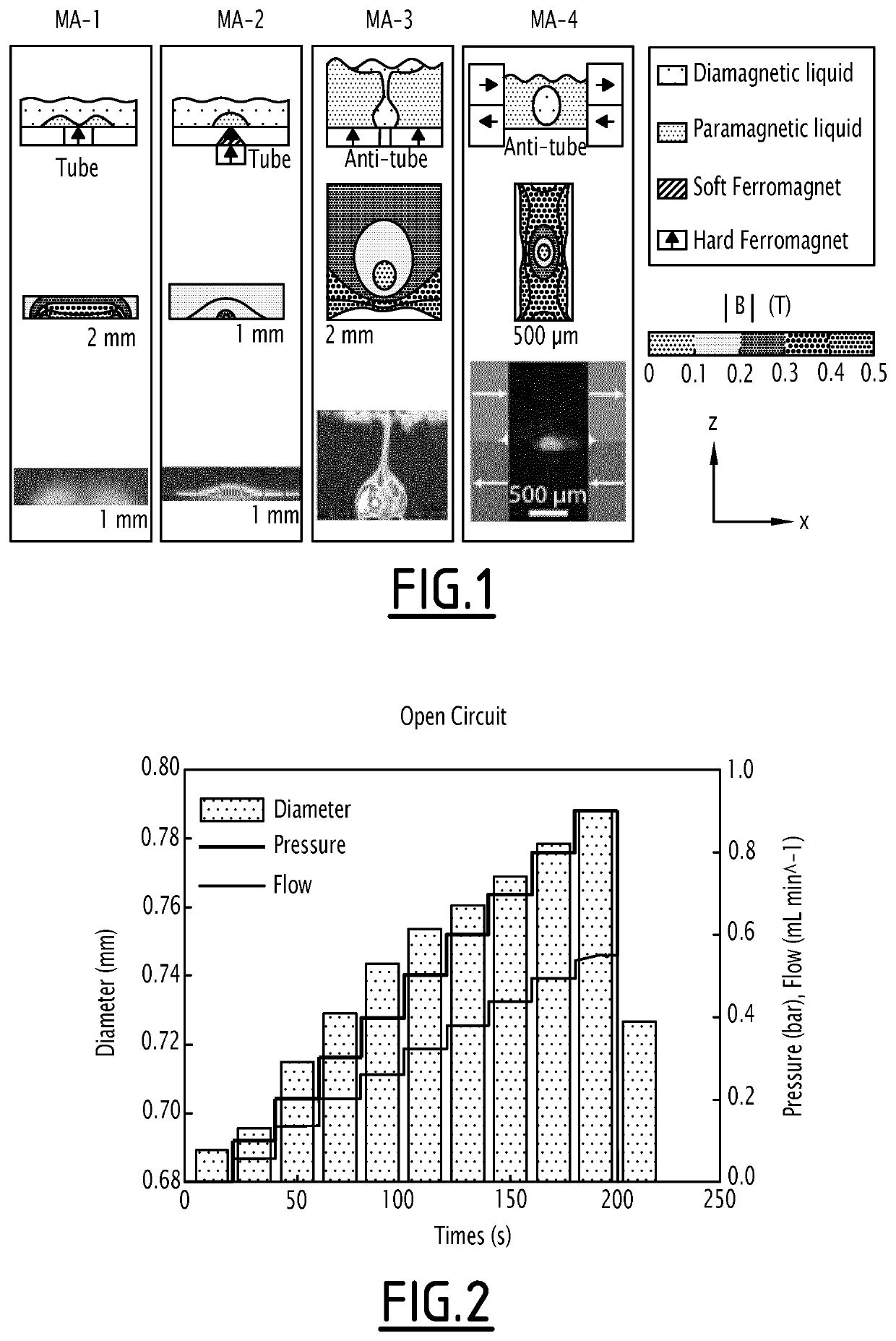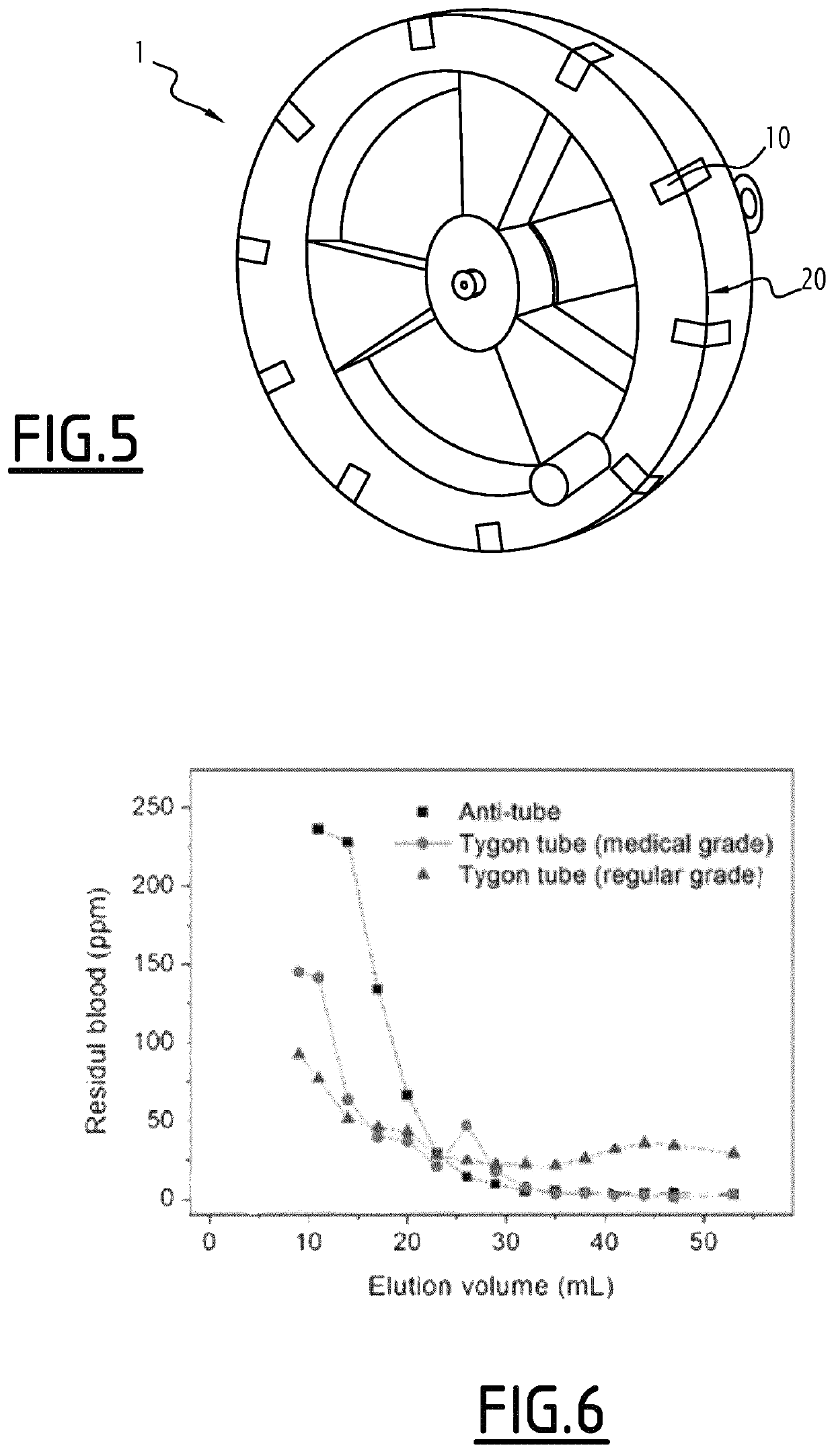Device and method for circulating liquids
a technology of liquid circulation and liquid tubes, applied in the direction of positive displacement liquid engines, pump control, dynamo-electric machines, etc., can solve the problems of limited lifetime of paramagnetic liquid tubes, low reynolds number, and limited stable geometries of microfluidic circuitry, so as to limit the negative impact of mechanical moving parts
- Summary
- Abstract
- Description
- Claims
- Application Information
AI Technical Summary
Benefits of technology
Problems solved by technology
Method used
Image
Examples
example 1
queous Liquid Anti-Tubes
[0153]A range of different magnet arrangements have been used to stabilize paramagnetic liquid anti-tubes (i.e., a tube of a diamagnetic liquid within a paramagnetic fluid). The paramagnetic liquid in this section is made by dissolving holmium chloride (HoCl3) in water, whereas the diamagnetic (less paramagnetic) liquid is pure water. In all cases small commercially available NdFeB magnets were used to fabricate the magnet arrangements and the tube was visualized by confocal microscopy (using Rhodamine B as a dye). For each of four magnet arrangements MA1-4 the following three types of information are shown in FIG. 1.
[0154]In FIG. 1:
[0155]a) Schematic of liquid tube and anti-tube confinement for four magnet arrangements, the first two stabilize tubes of paramagnetic HoCl3 in water, the last two stabilize anti-tubes of water or LaCl3 in HoCl3; b) analytically evaluated contour plots of |B| for the geometries; c) confocal cross-section fluorescence images of rh...
example 2
ily Anti-Tubes
[0158]The inventors noted that anti-tubes described in example 1 have only a limited life-time when the paramagnetic liquid is an aqueous solution of paramagnetic ions and the less-paramagnetic liquid is pure diamagnetic water, due to diffusion of Ho3+ ions across the paramagnetic / diamagnetic boundary. The ion diffusion reduces the difference in magnetic susceptibility between the two initially well-defined regions, which in turn lowers the magnetic pressure and bulk forces. However, when implementing two liquids that are immiscible by replacing the aqueous paramagnetic liquid by an (APG 300, Ferrotec) oil-based ferrofluid, any transport across the boundary was prevented, and thus leads to anti-tubes that are stable for months. The anti-tube diameter can be measured from the side-view of the device using a stereoscope in transmission mode. To characterize the behaviour of the anti-tube a series of pressure experiments was performed. Firstly, a defined pressure was appl...
example 3
f Elements Generating a Magnetic Field
[0159]3.1. Quadrupole
[0160]The inventors have designed magnetic arrays to form an anti-tube by magnetic field simulations (using either finite element methods or analytical expressions using SciPy) and prototyping (using a 3D printer). With a quadrupole magnet arrangement it is possible to achieve stable anti-tubes of virtually any diamagnetic liquid that is immiscible with the paramagnetic medium as shown in FIG. 4.
[0161]A commercial ferrofluid (black colour) was used as paramagnetic liquid and water as diamagnetic liquid. Water that was flowed through the ferrofluid remained clear and transparent further supporting the stability of the anti-tube. Water flows freely through the black oily ferrofluid without being contaminated by the paramagnetic liquid. In other words, the combination of the quadrupole magnets and the ferrofluid results in a channel with liquid walls.
[0162]3.2. Single Sided Designs
[0163]Single sided designs are suitable when bu...
PUM
| Property | Measurement | Unit |
|---|---|---|
| size | aaaaa | aaaaa |
| size | aaaaa | aaaaa |
| pressures | aaaaa | aaaaa |
Abstract
Description
Claims
Application Information
 Login to View More
Login to View More - R&D
- Intellectual Property
- Life Sciences
- Materials
- Tech Scout
- Unparalleled Data Quality
- Higher Quality Content
- 60% Fewer Hallucinations
Browse by: Latest US Patents, China's latest patents, Technical Efficacy Thesaurus, Application Domain, Technology Topic, Popular Technical Reports.
© 2025 PatSnap. All rights reserved.Legal|Privacy policy|Modern Slavery Act Transparency Statement|Sitemap|About US| Contact US: help@patsnap.com



